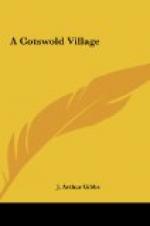Fairford Church is known far and wide as containing the most beautiful painted glass of the early part of the sixteenth century to be found anywhere in England. The windows, twenty-eight in number, are usually attributed to Albert Duerer; but Mr. J.G. Joyce, who published a treatise on them some twenty years ago, together with certain other high authorities, considered them to be of English design and workmanship. They would doubtless have been destroyed in the time of the Civil Wars by the Puritans had they not been taken down and hidden away by a member of the Oldysworth family, whose tomb is in the middle chancel.
John Tame, having purchased the manor of Fairford in 1498, immediately set about building the church. He died two years later, and his son completed the building, and also erected two other very fine churches in the neighbourhood—those at Rendcombe and Barnsley. He was a great benefactor to the Cotswold country. Leland tells us that the town of Fairford never flourished “before the cumming of the Tames into it.”
You may see John Tame’s effigy on his tomb, together with that of his wife, and underneath these pathetic lines:
“For thus, Love,
pray for me.
I may not pray
more, pray ye:
With a pater noster
and an ave:
That my paynys
relessyd be.”
If I remember rightly his helmet and other parts of his armour still hang on the church wall. Leland describes Fairford as a “praty uplandish towne,” meaning, I suppose, that it is situated on high ground. It is certainly a delightful old-fashioned place—a very good type of what the Cotswold towns are like. Chipping-Campden and Burford are, however, the two most typical Cotswold towns I know.




